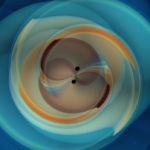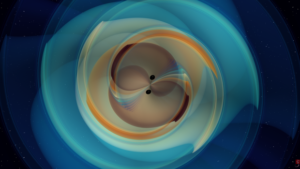
Virgo and LIGO unveil new and unexpected black hole populations

A still image from a numerical simulation of two black holes that inspiral and merge, emitting gravitational waves. The simulated gravitational wave signal is consistent with the GW190521 observation made by the LIGO and Virgo. (Credit: N. Fischer, H. Pfeiffer, A. Buonanno (Max Planck Institute for Gravitational Physics), Simulating eXtreme Spacetimes (SXS) Collaboration)
 Virgo and LIGO have announced the detection of an extraordinarily massive merging binary system: two black holes of 66 and 85 solar masses, which generated a final black hole of around 142 solar
Virgo and LIGO have announced the detection of an extraordinarily massive merging binary system: two black holes of 66 and 85 solar masses, which generated a final black hole of around 142 solar
masses. The remnant black hole is the most massive ever detected with gravitational waves. It lies in a range of mass (from 100 to 1000 solar masses) within which a black hole has never before been
observed, either via gravitational waves or electromagnetic observations, and may help to explain the formation of supermassive black holes. Moreover, the most massive component of the binary
system lies in a mass range forbidden by stellar evolution theory and challenges our understanding of the final stages of massive stars life.
For more details, read the full press release and see the GW190521 detection page.
Further information:
- Virgo Collaboration news item on GW190521
- EGO news item on GW190521
- LIGO Lab news item on GW190521
- Webinar on YouTube: https://www.youtube.com/SDkTtZJaULw
- Publications:
- GW190521: A Binary Black Hole Merger with a Total Mass of 150 Msun (published in Physical Review Letters).
- Properties and astrophysical implications of the 150 Msun binary black hole merger GW190521 (published in The Astrophysical Journal Letters).



